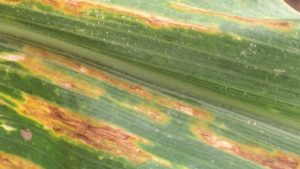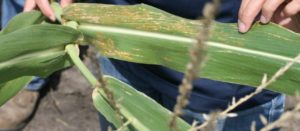by Dr. Ron French, Extension Plant Pathologist, Texas A&M AgriLife Extension Service, Amarillo rdfrench@ag.tamu.edu
Dr. Tom Isakeit, Extension Plant Pathologist, Texas A&M AgriLife Extension Service, TAMU College Station t-isakeit@tamu.edu
In June and July, corn leaves with brown, tan, orange to reddish streaks or stripes were observed in a few fields in Hansford and Hutchinson counties in the Texas Panhandle. The lesions were initially present between leaf veins (Figure 1) but later extended beyond the veins, with a wavy, uneven shape rather than rectangular shape (Figure 2). The lesions varied in length from half an inch to several inches and occurred throughout the leaf blade (Figure 3). The lesions were translucent when held up to the light (Figure 4). These foliar symptoms were also seen in several other states. The disease, bacterial streak, caused by Xanthomonas vasicola pv. vasculorum, was confirmed for Texas by Texas A&M AgriLife Extension Plant Pathology, the Great Plains Diagnostic Network Regional Lab, and the USDA. This disease has not been confirmed in other corn production areas of Texas.

Figure 1. Initial lesions or streaks caused by the bacterium Xanthomonas vasicola pv. vasculorum on corn in the Texas Panhandle. Lesions may extend beyond the veins.

Figure 2. Longer lesions or streaks caused by the bacterial leaf streak pathogen Xanthomonas vasicola pv. vasculorum in the Texas Panhandle.
Currently, there is no indication that this disease can cause adverse impacts in yield or quality in any of the states where it has been found. Although many diseases caused by species of Xanthomonas can be seedborne on numerous other crops, currently, it is not known if bacterial leaf streak is seedborne.
When scouting for bacterial leaf streak in corn, one needs to be careful not to confuse its early symptoms with gray leaf spot, a fungal disease caused by Cercospora spp. Gray leaf spot appears as rectangular lesions or stripes which are smooth and tend to stay within the veins (Figure 5). These lesions are initially tan and later may appear gray as the fungus produces spores. Advanced symptoms of gray leaf spot are quite different from bacterial leaf streak (Figure 6). Because gray leaf spot is dependent on hot weather, high relative humidity, and moisture on the leaves, it may be more prevalent during flowering while bacterial leaf streak has been observed as early as V7 (seven leaf collar). In Texas corn growing areas other than the High Plains, gray leaf spot is a minor disease, if it occurs at all.

Figute 6. More extensive symptoms of gray leaf spot. Lesions have coalesced or overlapped between one another.

Figure 5. Gray leaf spot in corn in the Texas Panhandle. Rectangular lesions remain within the veins.
As a general recommendation for managing bacterial diseases, crop rotation should be practiced and weeds, especially grasses, should be controlled. For bacterial diseases of corn, there are no chemical treatments available. Time will tell whether bacterial leaf streak becomes an important disease in Texas, but as this disease becomes the subject of research, we can expect to see more information on hybrid susceptibility and factors affecting disease severity. For more information on this and other corn diseases, go to: http://sickcorn.tamu.edu.


